Attention: The direction of rotation given in the text refers to rotation when viewed from the front of the motor.
Removing
Note: This section describes the procedure for removing and installing the camshaft with front cover. If the front cover is removed first, change the order of the following operations:
- step 8: After removing the camshaft sprocket, remove the camshaft brackets (№№2-5).
- Step 9: The exhaust camshaft can be removed at the same time as the intake camshaft.
- step 10: It is not necessary to lift the camshaft when loosening the fixing bolt of the intake camshaft.
1. Support the bottom of the engine with a telescoping stand, then remove the right engine support bracket and insulator. See section «Complete engine».
2. Remove the valve cover. See section «Valve lid».
3. Remove the camshaft angle sensor (PHASE) on the back of the cylinder head.
Caution: Handle the sensor with care, do not drop or hit it.
4. Set the piston of cylinder No. 1 to TDC on the compression stroke as follows:
- A. Check crankshaft pulley (2) clockwise and align the timing mark (colorless risk) (A) with sync pointer (1) on the front cover.
- b. Make sure the alignment marks on the camshaft sprockets are aligned as shown.
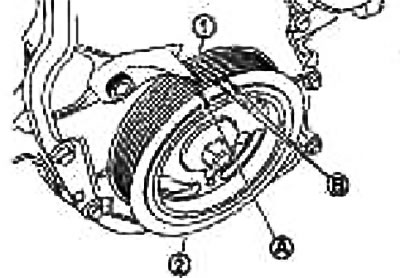
B. White paint mark (not used for maintenance)
Otherwise, turn the crankshaft pulley one more turn and align the marks as shown in the figure
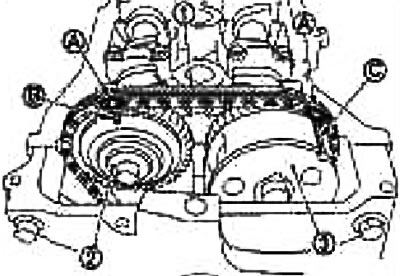
1. Timing chain; 2. Exhaust camshaft sprocket; 3. Intake camshaft sprocket; A. Registration mark (paint); B. Registration mark (knocked out); C. Registration mark (risk carved on the periphery)
- With. Paint alignment marks (A) on timing chain links
5. Lock the chain tensioner plunger in the fully compressed position as follows. Then loosen the timing chain tension
- A. Take out the plug (2) from the front cover (1)
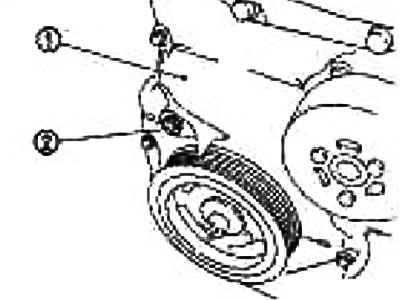
- b. Fully push the lever (IN) chain tensioner (2) through the plug hole and insert the locking pin (A) into the hole in the tensioner housing and lock the lever in the lower position.
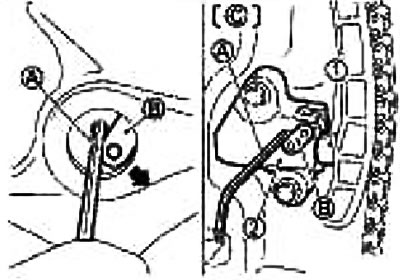
C. Front cover not shown
Plunger retaining tab (1) can be released by fully pushing the lever (coaxial with lever design). As a result, the plunger can be moved.
Note: A hexagon wrench is used instead of a locking pin as an example (2.5mm).
Caution: The locking pin must be shaped to prevent it from falling into the front cover if it falls out.
- With. Check crankshaft pulley (2) counterclockwise, locking the exhaust camshaft (1). Tension the timing chain and push the plunger into the chain tensioner.
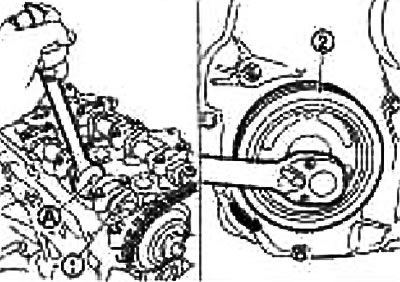
Attention: Fix the camshaft at the hexagonal part (A) so that it doesn't rotate.
- d. Remove lock pin (A) chain tensioner (2) from the plug hole. Raise the lever (IN) and align the hole in it with the hole in the case.
Aligning the holes in the lever (WITH) and the body can fix the plunger (1).
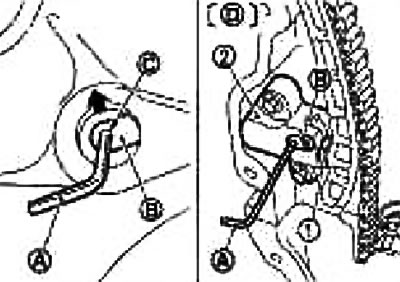
D. Front cover not shown
When the protrusions of the plunger ratchet and locking tab face each other, the holes are not aligned. Engage them correctly and align these holes by moving the plunger slightly.
- e. Insert the locking pin into the hole in the tensioner body through the hole in the lever and lock the lever in the up position.
- f. Slightly turn the crankshaft pulley (2) clockwise and loosen the timing chain from the exhaust camshaft sprocket side (1) (see fig. below).
Attention: Fix the camshaft at the hexagonal part (A) so that it doesn't rotate.
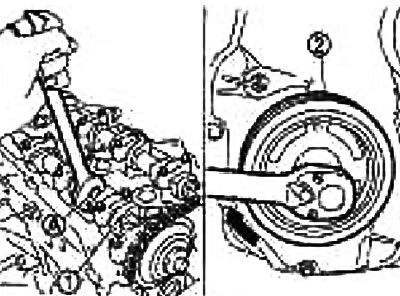
6. Remove exhaust camshaft sprocket (1)
Attention:
- Fix the camshaft at the hex part (A) so that it doesn't rotate.
- After removing the timing chain, do not turn the crankshaft or camshaft separately, otherwise the valves will hit the piston bottoms.
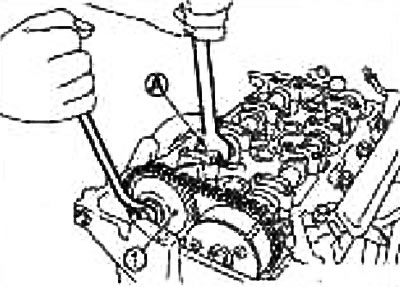
Note: The timing chain with the front cover installed will not disengage from the crankshaft sprocket and fall into the front cover. Therefore, a device to maintain the timing chain tension is not required.
7. Turn the intake camshaft sprocket to the maximum advanced position.
Attention:
- Removal and installation of the intake camshaft sprocket in the maximum advanced position is required for the following reasons. Therefore, follow the procedure exactly as indicated below.
- On this model, a design is used in which the sprocket (WITH) and blade (together camshaft joint) (IN) rotate and move relative to each other at some given angles.
- When the engine is stopped, the blade is in the position of maximum delay. It does not rotate because it is locked in the sprocket by an internal locking pin (A).
- If you turn the camshaft sprocket mounting bolts under the specified conditions, then apply a lateral load (shear force) to the locking pin. This will damage the stop pin and cause the mechanism to malfunction.
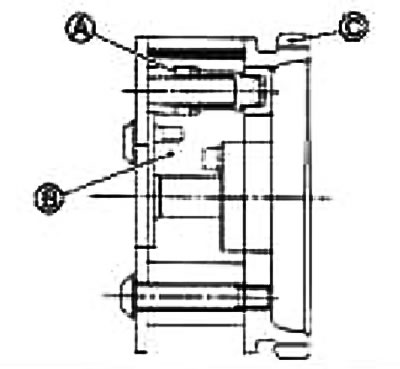
Set the intake camshaft sprocket to the maximum advanced position as follows:
- A. Remove bracket (Nel) camshafts (1)
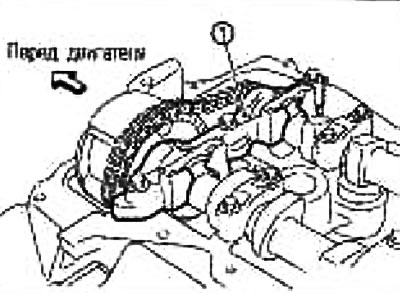
Loosen the bolts in several passes and unscrew them.
- b. Using an air gun, apply pressure to the #1 neck lubrication port (A) inlet camshaft (1).
Air pressure: 300 kPa (3.1 kg/cm2) or more
Apply pressure to the oil hole in the second groove from the front thrust surface (IN) camshaft.
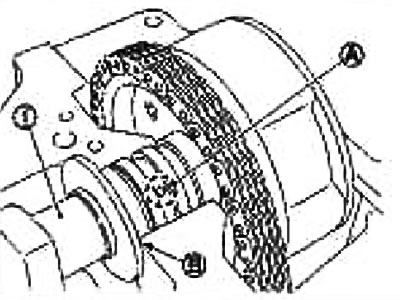
Maintain pressure until the end of the paragraph «e».
To prevent air from leaking out of the lubrication port, press down on the rubber tip (IN), tapering towards the end of the airgun (A) Apply pressure to the lubrication port securely.
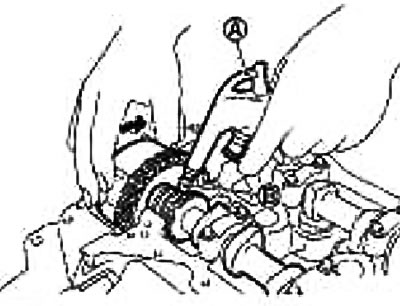
Attention:
- There are other lubrication holes in the side grooves. Don't mix them up.
- Do not damage the lubrication channel with the tip of the gun.
- To prevent oil from being blown in with air, carefully wipe the oil from the gun and, when applying pressure, wipe the oil with a rag from the area adjacent to the gun. Wear protective goggles if necessary.
Note: The locking pin is held in the unlocked position by compressed air.
- With. Grab the intake camshaft sprocket with your hands and alternately apply counterclockwise/clockwise pressure.
Finally turn the intake camshaft sprocket counterclockwise in the direction of the arrow.
Carry out the operation by blowing compressed air into the oil hole.
If the locking pin does not release by hand, tap the intake camshaft sprocket lightly with a plastic mallet (A).
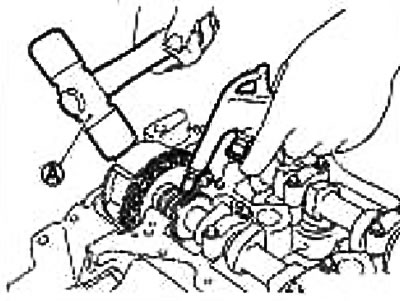
If the intake camshaft sprocket does not turn counterclockwise even when performing the above operation, check the air pressure and oil hole location.
- d. During the above operation, you will hear a clicking sound from inside the intake camshaft sprocket (sound indicating the disengagement of the internal locking pin). When you hear this sound, slowly turn the intake camshaft sprocket counterclockwise to its full advance position.
Carry out the operation with compressed air.
If the blade part (together camshaft joint) rotates one relative to the sprocket, then the locking pin is disengaged, even if the click is not heard.
Verify that the sprocket has reached its maximum advance position by looking to see if the lock pin grooves line up (A) and pin hole (IN), as shown in fig. below).
- e. Stop supplying compressed air and hold the intake camshaft.
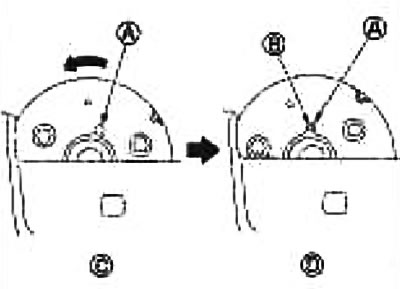
C. Locking pin engaged D. Maximum advance position
- f. Insert lock pin (A) into the holes in the intake camshaft sprocket and lock in the maximum advanced position.
Attention: load (spring reaction force, etc.) the locking pin is not applied and can easily fall out. So secure it with vinyl tape (IN).

Note: A hexagon wrench is used instead of a locking pin as an example (2.5 mm) (insertion length approx. 15 mm).
8. Remove brackets (№№ 2-5) camshafts.
Loosen the mounting bolts in several passes in the reverse order of the illustration.
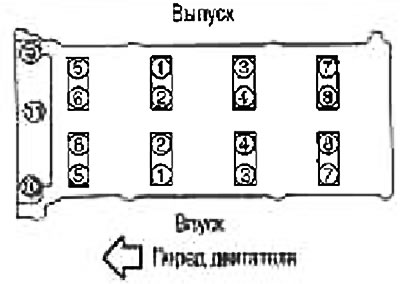
Note: Bracket (№1) camshafts have already been removed.
9. Remove the exhaust camshaft.
10. Remove the intake camshaft (1) and intake camshaft sprocket (2) in the following way:
- A. Raise the intake camshaft sprocket and fit a flat tool (ring wrench, etc) on fixing bolt (A).
- b. Carefully lower the intake camshaft onto the cylinder head journals.
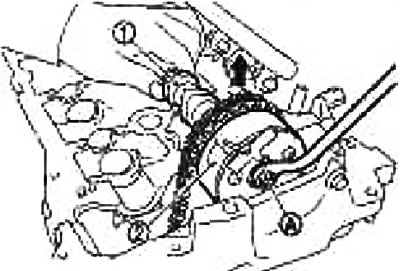
- With. Continuing to hold the hex part of the camshaft (A) adjustable wrench, loosen the fixing bolts of the intake camshaft sprocket (2).
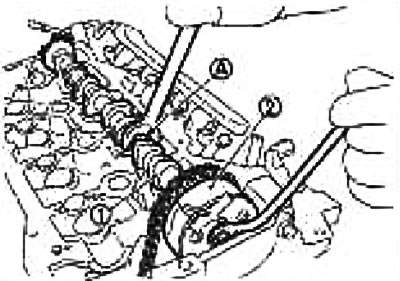
1. Intake camshaft
- d. Raise intake camshaft (1) and separate it from the asterisk (2).
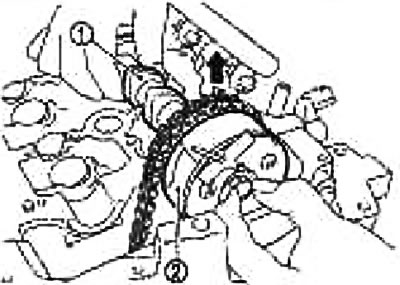
- e. Remove the intake camshaft towards the rear.
Attention: Be careful not to damage the signal disk on the rear end.
- f. Remove the intake camshaft sprocket (1).
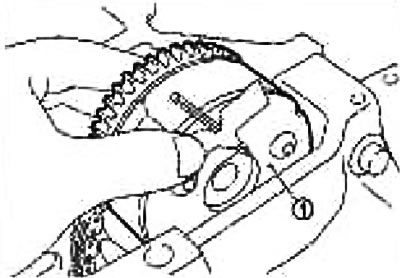
Attention:
- Do not drop the lock pin.
- To stop pin (IN) didn't fall out, secure it with vinyl tape (WITH).
- Handle the camshaft sprocket with care, do not strike it or drop it.
- Don't disassemble the asterisk. [Do not loosen the three bolts (A) on the front surface].
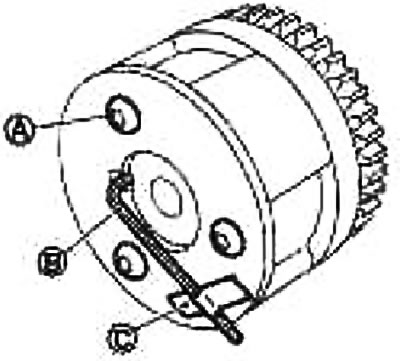
Note: If, while removing the intake camshaft sprocket, when you removed the lock pin and the lock pin engaged in the maximum retard position, restore the original position as follows:
- i. Install the intake camshaft sprocket back onto the camshaft and tighten the mounting bolts to prevent air leakage.
Caution: To avoid damage to the internal locking pin, the tightening torque of the fixing bolts must be kept to a minimum so as to avoid air leakage.
- ii. Apply compressed air, disengage the lock pin and rotate the blade to the maximum advanced position.
- iii. Insert lock pin.
- iv. Remove the sprocket from the camshaft.
11. Remove the valve lifters.
Mark the locations and stack the components in order without mixing them.
12. Remove the electrovalve of the mechanism of regulation of phases of gas distribution of inlet valves (1).
13. Remove the generator and bracket, unscrew the plug (2) and remove the oil filter. See chapter electrical equipment.
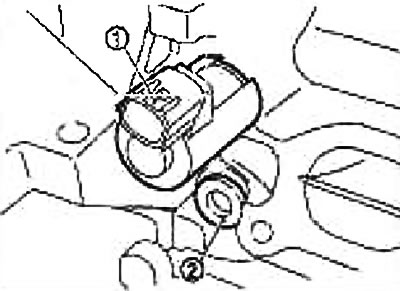
Check after removal
Oil filter
Make sure the oil filter (1) no foreign particles check if it is clogged.
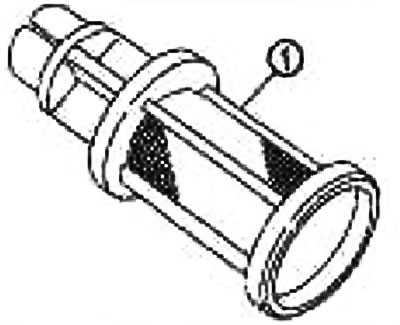
Check the oil filter for damage.
If damaged, replace the oil filter, plug and washer as a set.
Camshaft runout
1. Install the camshaft on two prisms with necks #2 and #5.
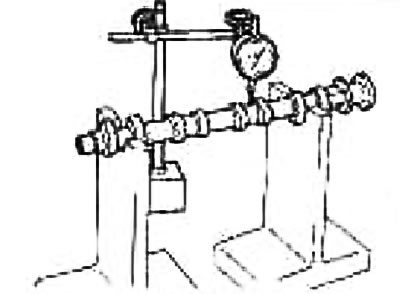
Attention: Do not install the camshaft on prisms with neck No. 1 (from the camshaft sprocket side), because its diameter differs from the other four.
2. Fix the sensitive head of the indicator vertically on the neck #3.
3. Turn the camshaft by hand in one direction and measure the runout with a dial gauge, (maximum indicator reading).
| Standard | 0.02mm |
| Limit | 0.1 mm |
4. If the runout exceeds the limit value, replace the camshaft.
Camshaft lobe height
1. Measure the camshaft lobe height with a micrometer (A).
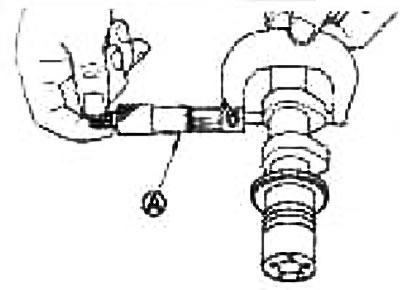
| Standard | |
| Inlet | 41.705-41.895 mm |
| Release | 40.175-40.65mm |
| Cam wear limit | 0.2mm |
If the height is out of specification, replace the camshaft.
Oil clearance in the camshaft journals
Camshaft journal outer diameter Measure the camshaft journal outer diameter with a micrometer (A).
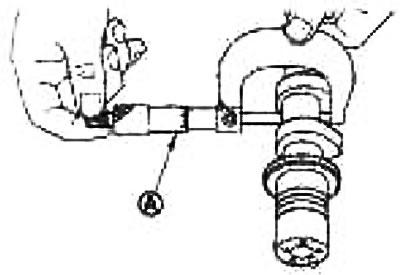
| Standard | №1 | 27.935-27.955 mm |
| №№2,3,4,5 | 24.950-24.970 mm |
Camshaft bracket inner diameter
Tighten the camshaft bracket bolts to the correct torque. For tightening torques, see section «Installation».
Measure the inner diameter (IN) camshaft bracket (A).
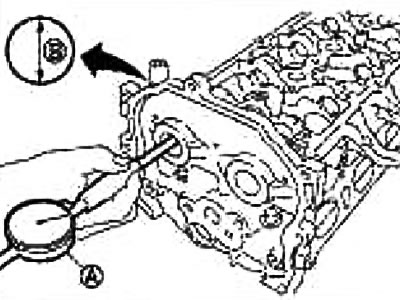
| Standard | №1 | 28.000-28.021 mm |
| № 2,3,4,5 | 25.000-25.021 mm |
Calculation of the oil clearance in the camshaft journals
(Oil gap in the necks) = (camshaft bracket inner diameter) - (camshaft journal outer diameter)
| Standard | №1 | 0.045-0.086mm |
| №№ 2,3,4,5 | 0.030-0.071 mm | |
| Limit | 0.15 mm |
If the reading is out of specification, replace either the camshaft or cylinder head, or both.
Note: The camshaft brackets are one piece with the cylinder head. Replace the cylinder head assembly.
Camshaft end play
1. Install the camshaft in the cylinder head. For tightening torques, see section «Installation».
2. Install the indicator (A) in the axial direction with a sensitive head to the front end of the camshaft. Measure the end play by moving the camshaft forward/back (axially).
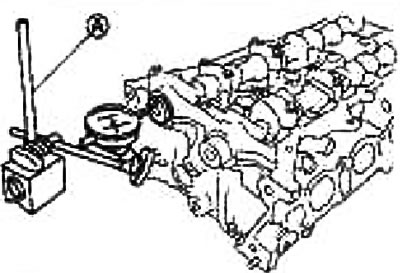
| Standard | 0.075-0.153 mm |
| Limit | 0.2mm |
If the end play is out of specification, measure the dimensions of the following components:
- Size «A» support bearing No. 1 of the cylinder head. Standard: 4,000-4,030 mm
- Size «IN» camshaft thrust surface. Standard: 3.077-3.925 mm
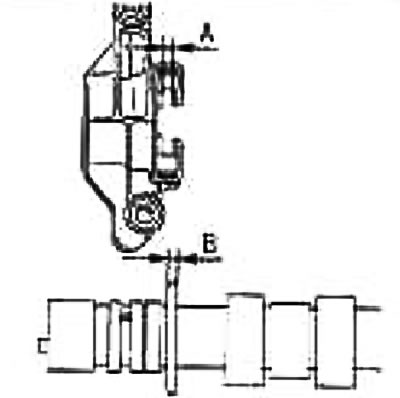
Compare the measurements with the standard values above and replace the camshaft and/or cylinder head.
Camshaft sprocket runout
1. Install the camshaft on two prisms with necks #2 and #5.
Attention: Do not install the camshaft on prisms with neck No. 1 (from the camshaft sprocket side), because its diameter differs from the other three.
2. Measure the runout of the camshaft sprocket with an indicator (maximum indicator reading).
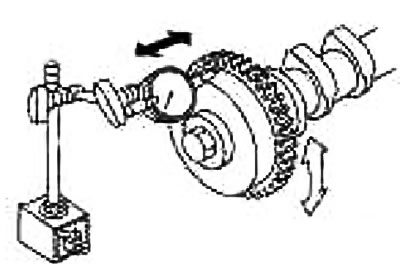
Limit: 0.15mm
If the runout exceeds the limit, replace the camshaft sprocket.
Valve tappet
Check for wear or chips on the surface of the valve lifter.
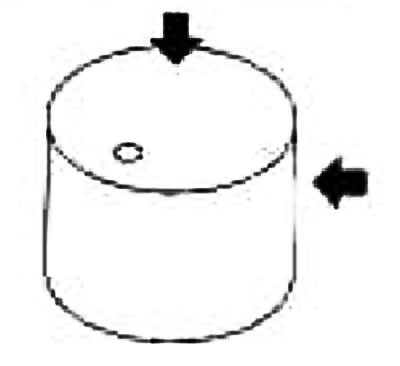
If any defects are found, replace the valve tappet.
Valve lifter clearance
Valve lifter outside diameter.
Measure the outer diameter with a micrometer (A) (see fig.).
Standard: 29.977-29.987mm
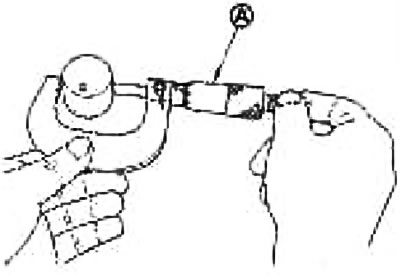
Valve tappet hole diameter.
Measure the diameter of the tappet bore in the cylinder head with a bore gauge (A).
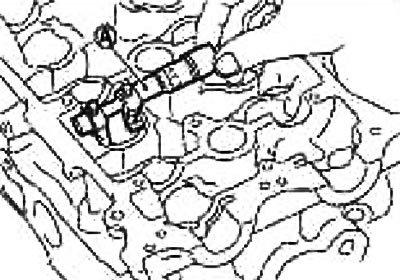
Standard: 30.000-30.021 mm.
Valve lifter clearance calculation
(Valve lifter clearance) = (tappet hole diameter) - (valve lifter outside diameter)
Standard: 0.013-0.044mm
If the value obtained is out of specification for the inner and outer diameters, replace either the valve lifter or cylinder head, or both.
Installation
1. Insert oil filter (1).
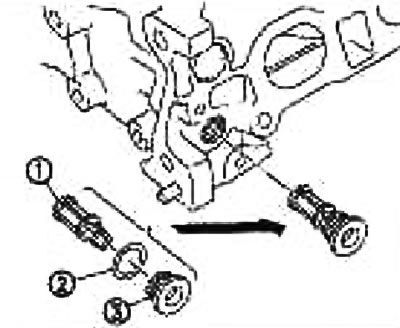
2. Washer
The oil filter is inserted into the plug (3), and then into the cylinder head.
2. Install the intake valve timing solenoid valve.
Insert it into the cylinder head at a right angle.
After fully inserting the valve, tighten the bolts.
3. Install the valve lifters.
In case of repeated use, install them in the same places in which they were before removal.
4. Apply alignment marks to install the intake camshaft and intake camshaft sprocket as follows:
Note: This operation is to prevent the guide tab from entering an unintended hole after installing the intake camshaft and intake camshaft sprocket.
- A. Apply alignment marks (A) at a right angle from the position of the guide on the front face of the intake camshaft (1).
Mark visible area with intake camshaft sprocket installed (The figure shows an example).
- b. Apply alignment marks at right angles from the position of the guide hole (IN) on the intake camshaft sprocket (2). (The figure shows an example).
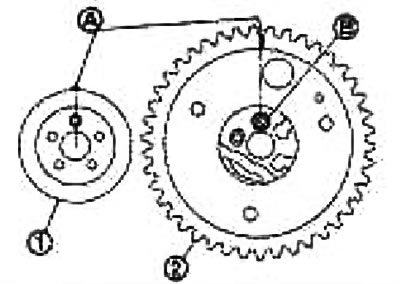
5. Install the intake camshaft sprocket between the cylinder head and front cover.
Install it with the guide hole (A) up.
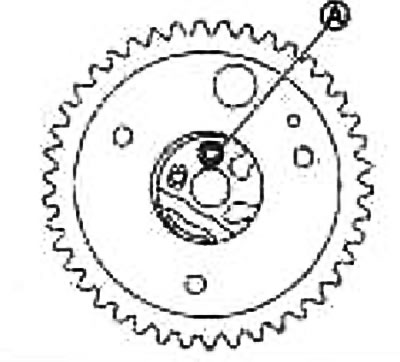
Caution: Make sure the lock pin is inserted in the maximum advanced position beforehand.
6. Install camshafts.
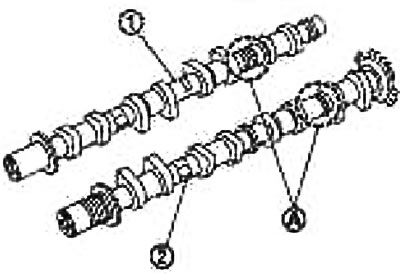
1. Exhaust camshaft
2. Intake camshaft
A. Distinguishing markings
The intake and exhaust camshafts can be distinguished by the shape of the rear ends.
Install the camshafts in the cylinder head so that the guide lugs (A) on the front ends stood up, as shown in the figure.
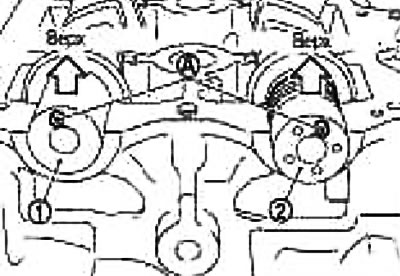
1. Exhaust camshaft
2. Intake camshaft
Note: Although the camshaft does not stop at the position shown in the figure to set the lobes, it is generally acceptable that the camshaft be installed in the same direction as in the figure.
7. Install the intake camshaft sprocket onto the intake camshaft as follows:
- A. Focus on alignment mark (A), applied in step 4. Align the guide tab and the hole for it and connect them.
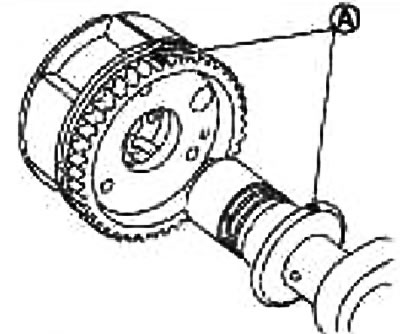
- b. Raise the front side of the intake camshaft (1) and hand tighten the bolt.
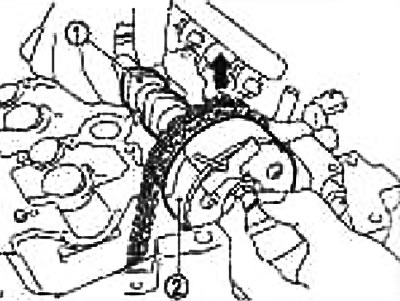
2. Intake camshaft sprocket.
8. Put a thick napkin underneath (IN) and put the tool on the bolt (A) by lifting the front side of the intake camshaft.
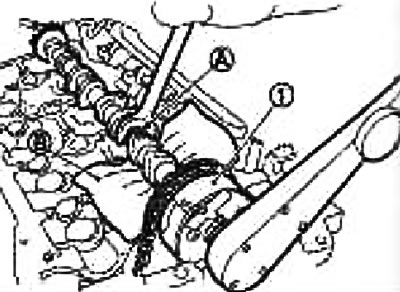
9. Tighten the mounting bolt.
Attention: Fix the camshaft at the hexagonal part (A) so that it doesn't rotate.
10. Carefully lower the intake camshaft onto the cylinder head journals.
11. Put on the timing chain (1), aligning the label (applied to it upon removal) (IN) labeled (risk carved on the periphery) (A) on the intake camshaft sprocket (2).
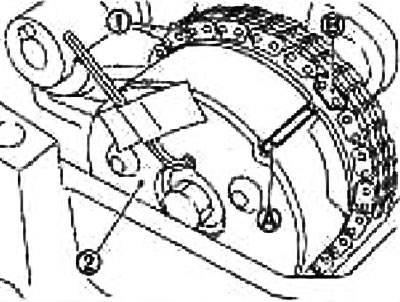
12. Install brackets (№№2-5) camshafts, guided by a distinctive marking embossed on the upper surface.
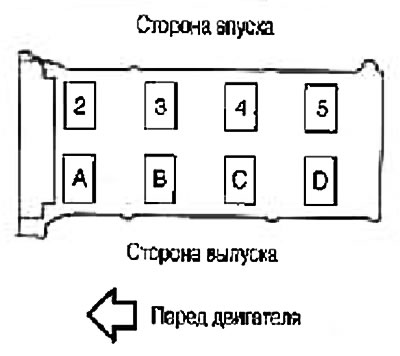
Install so that the decal is read correctly when viewed from the intake side.
13. Tighten the mounting bolts of the camshaft brackets in the order indicated by the numbers in the figure, as follows:
- A. Tighten in order from 9 to 11.
Tightening torque: 2.0 Nm (0.2 kg m)
- b. Tighten in order from 1 to 8.
Torque: 2.0*m (0.2 kg m)
- c. Tighten all bolts in the order indicated by the numbers in the figure.
Tightening torque: 5.9 Nm (0.6 kg m)
- d. Re-tighten all bolts in the order indicated by the numbers in the figure.
Tightening torque: 10.4 Nm (1.1 kg m)
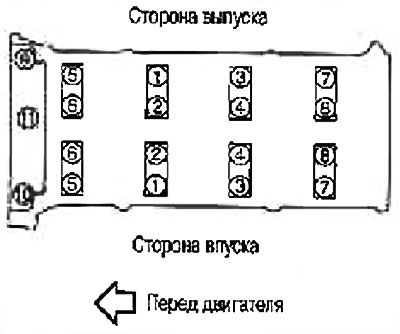
14. Install the exhaust camshaft into the sprocket (2), aligning the label (applied to it when removing the timing chain) (A) labeled (embossed) (IN) on the exhaust camshaft sprocket.
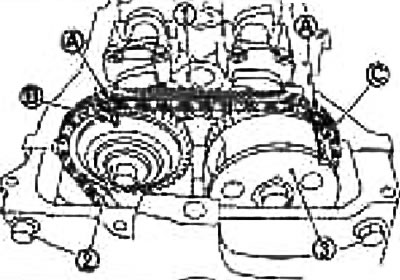
1. Timing chain
3. Exhaust camshaft sprocket
C. Registration mark (risk carved on the periphery)
If the position of the guide tab and the groove for it are not aligned, turn the exhaust camshaft slightly and align
15. Tighten the mounting bolt.
Attention: Fix the camshaft at the hexagonal part (A) so that it doesn't rotate. Make sure the marks on the intake and exhaust camshaft sprockets (applied to them when removing the timing chain) aligned with the marks on the timing chain.
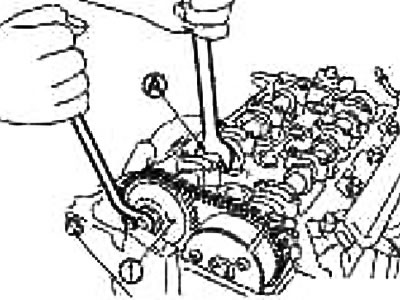
1. Exhaust camshaft sprocket.
16. Remove the lock pin (A) and tighten the timing chain by slightly turning the crankshaft pulley clockwise.
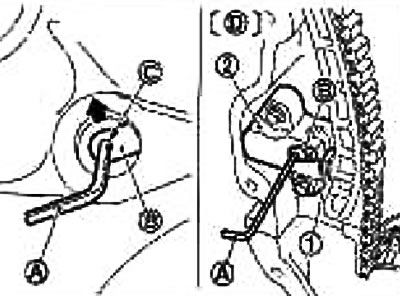
1. Plunger
2. Chain tensioner
B. Lever
C. Lever hole
D. Front cover not shown
17. Screw in the cap (2) into the front cover.
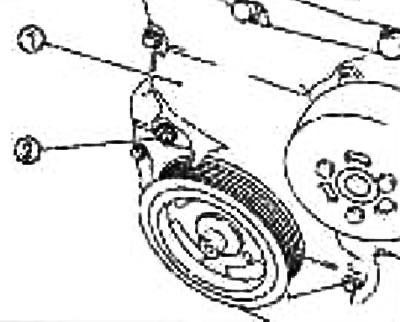
Apply sealant to the threads and screw in.
Use branded sealant or equivalent.
18. Return the intake camshaft sprocket to the maximum retard position as follows:
- A. Remove lock pin (A) from the intake camshaft sprocket.
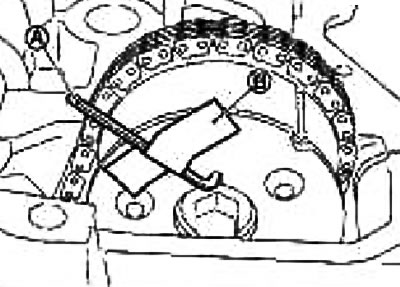
V. Ribbon
- b. Slowly turn the crankshaft pulley (1) clockwise (A) and return the intake camshaft sprocket to its maximum retard position.
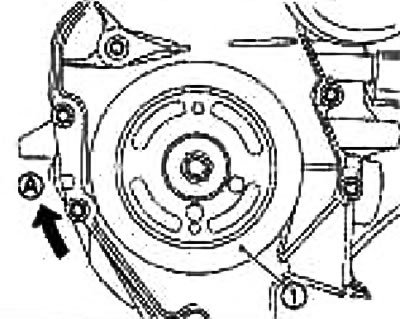
When the crankshaft rotates for the first time, the sprocket starts to rotate Continue to rotate the crankshaft until the vane also begins to rotate (camshaft), the position of maximum delay has been reached.
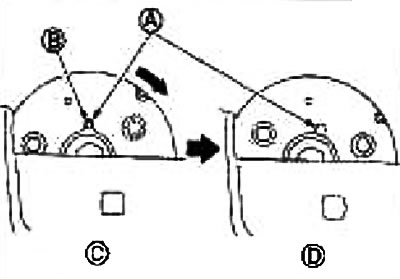
B. Lock pin hole
C. Position of maximum lag
D. Locking pin engaged
You can check if the maximum lag position has been reached by seeing if the slot has moved (A) under the locking pin clockwise.
Slightly turning the crankshaft counterclockwise. You can verify that the lock pin is engaged by seeing that the blade (camshaft) and sprocket rotate together.
19. Install the camshaft angle sensor (PHASE) on the rear end of the cylinder head.
Tighten the bolts making sure the sensor is fully seated in the mounting hole.
20. Check and adjust valve clearances. See section «valve clearances».
21. After this operation, installation is carried out in the reverse order of removal.
Check after installation
Leak Check
The following are procedures for checking fluid, engine oil, and exhaust leaks.
Before starting the engine, check the oil/fluid levels, including engine coolant and engine oil. If the level is below normal, add and bring to the required level. See chapter General information and maintenance.
Check for fuel leaks as follows:
- Turn the ignition key to position «ON» (without starting the engine) After pressurizing the fuel lines, check for fuel leaks at the joints.
- Start the engine. While increasing the engine speed, check again for fuel leaks at the fuel line joints
Let the engine run and check for unusual noise or vibration.
Note: If the hydraulic pressure inside the timing chain tensioner drops after removal/installation, slack in the guide may cause a thud during and immediately after starting the engine. However, this does not indicate a malfunction. The knock will stop when the hydraulic pressure rises.
Warm up the engine well and check for fuel, exhaust, or oil/fluid leaks, including engine coolant and engine oil.
Bleed the pipes and hoses of the relevant systems, such as the cooling system.
After the engine has cooled down, check the oil/fluid levels again, including engine coolant and engine oil. Top up if necessary and bring to the required level.
Check table
| Component | Before starting the engine | Engine running | After stopping the engine |
| Engine coolant | Level | A leak | Level |
| Engine oil | Level | A leak | Level |
| Other oils and fluids* | Level | A leak | Level |
| Fuel | A leak | A leak | A leak |
| Traffic fumes | - | A leak | - |
*Liquid for manual transmission, automatic transmission, brake fluid, etc.
Checking the oil groove on the intake camshaft sprocket
Caution: To avoid burns from engine oil splashes, carry out the inspection when the engine is cold.
1. Check engine oil level. See chapter Lubrication system and engine cooling system.
2. Perform the following procedure so as to avoid accidentally starting the engine during the test.
- A. Relieve fuel pressure. See chapter Engine management system.
- b. Remove the upper part of the intake manifold. See section «upper intake manifold».
- With. Disconnect connectors from ignition coils and injectors.
3 Remove the intake valve timing solenoid valve. See section «camshaft».
4. Turn the engine over and check if engine oil is leaking from the oil hole (A) covers of the mechanism for regulating the valve timing of the intake valves. Stop turning after checking.
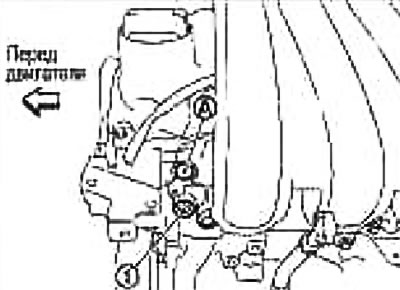
1. Plug
Attention:
- Do not touch rotating components (drive belts, idler pulley and crankshaft pulley, etc.).
- To prevent splashing oil on a person and getting burns, as well as getting dirt into the oil, use a napkin.
- Use a paper towel to protect engine and vehicle components from oil. Keep engine oil away from rubber parts such as the drive belt or engine mount insulators. Wipe up spilled engine oil immediately.
5. If engine oil does not leak from the oil hole of the intake valve timing cover in the cylinder head, perform the following check.
Remove the oil filter and clean it. See chapter Lubrication system and engine cooling system.
Clean the oil groove between the coarse filter and the solenoid valve of the intake valve timing mechanism. See section «Oil filter».
6. Remove the components between the intake camshaft solenoid valve and the intake camshaft sprocket, and check that the oil grooves are not clogged.
Clean the oil groove if necessary. See chapter Lubrication system and engine cooling system.
7. After checking, install the removed components in the reverse order of removal.